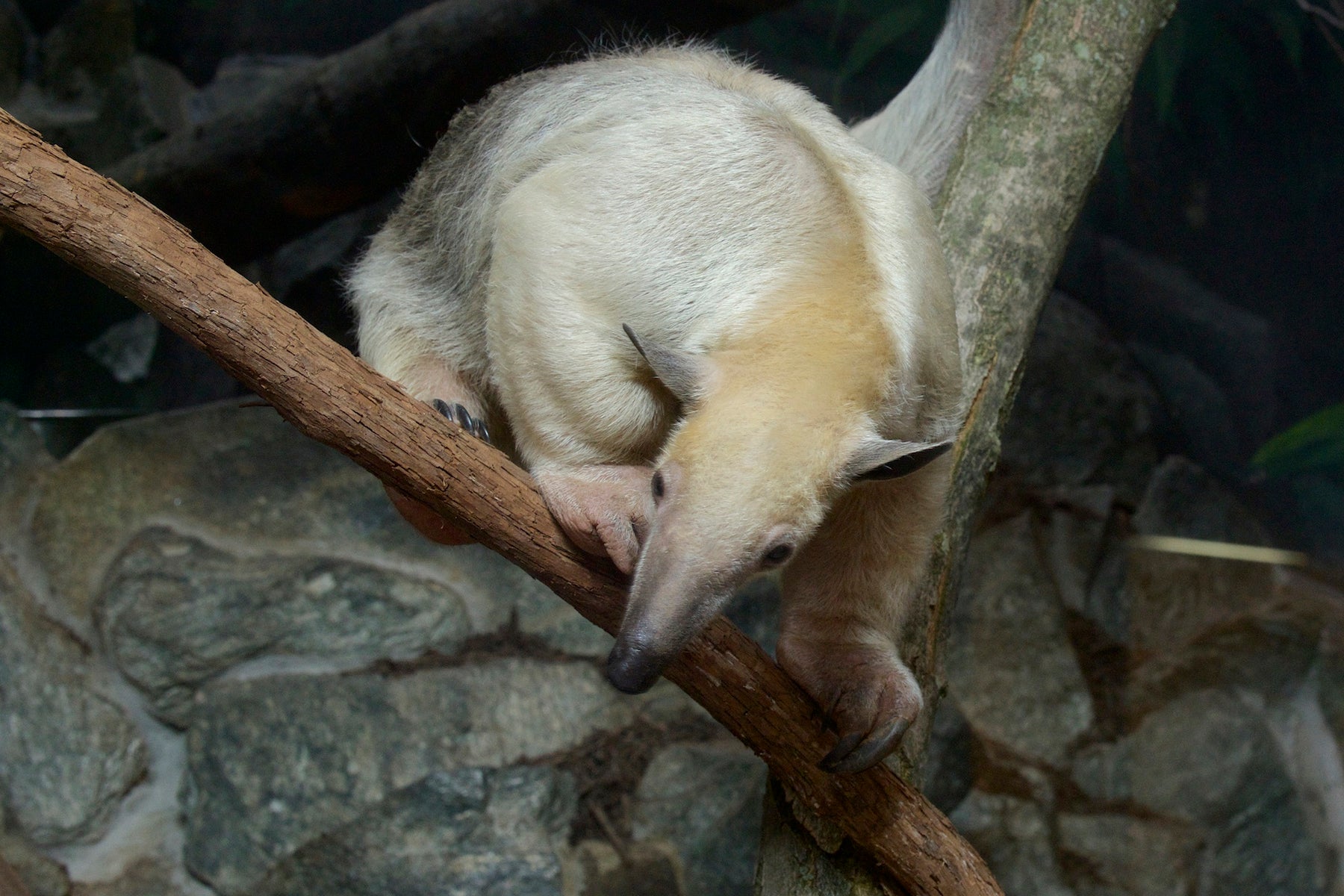How the Zoo’s Veterinary Team Solved a Cardiac Conundrum

Nine-year-old Cayenne is believed to be the first tamandua to receive an implantable heart monitor.
It began with an anomaly.
Last September, keepers at the Zoo’s Small Mammal House noticed one of the southern tamanduas fall from his perch. As an arboreal species of anteater, 9-year-old Cayenne is an expert tree-climber. A fall might be unusual, but not unheard of. Then it happened again. And again.
Cayenne was erratically collapsing on exhibit and falling out of his perches. It became a weekly occurrence, according to Kenton Kerns, the assistant curator of the Small Mammal House, and it seemed as though the episodes were increasing.
“He was hospitalized for about two weeks in October while we tried to understand what was going on,” explained Kerns. The Zoo's veterinary team started Cayenne on heart medication, and it seemed as though Cayenne’s condition was stable. Until he had another episode, which landed him back in the Zoo hospital for an additional 25 days.
Examinations revealed Cayenne was suffering from hypertrophic cardiomyopathy, a condition where the muscles of the heart thicken, making it more difficult for the heart to effectively pump blood. Hypertrophic cardiomyopathy can lead to a backup of fluid into the lungs and liver. Common complications include arrhythmia –an irregular heartbeat rhythm—and fainting spells.
“When Cayenne returned to his exhibit, keepers had created a more accessible space, with lower perches so that in case Cayenne had another episode, he wouldn’t be injured in his fall,” Kerns said. “His medications have kept him stable since November.”
While there’s currently no cure for hypertrophic cardiomyopathy, Cayenne’s medications should keep his heart condition under control and allow for him to live a full life. But close monitoring of Cayenne’s heart is critical should the medications fail, or the dosage require adjustments.
“We suspect these episodes are due to irregular heart rhythms,” said Zoo veterinarian Sarrah Kaye. “But since the irregular rhythms are transient, by the time we evaluate him, the event is usually over.”
With a need for consistent monitoring, the team turned to human medicine for a solution.
Tech for a Tamandua
Since 2018, researcher Rosana Nogueira de Moraes has run the Smithsonian’s Rhythm of Life initiative. The project uses implantable heart monitoring devices donated by medical device company Medtronic to evaluate an animal’s stress responses to different things in its environment with the goal of advancing animal wellbeing and species conservation.
“After implanting the device, we can continuously collect data without disturbing the animal,” said Moraes. “The heart monitors allow us to identify any abnormal cardiac rhythm, which could be a tremendous help in diagnosing and treating the condition.”
Moraes has used the implantable heart monitors to study more than 60 animals, including maned wolves, scimitar-horned oryx, jaguars and giant anteaters, both in the wild and under human care at the Zoo’s conservation facility in Front Royal, Virginia. Zoo veterinarian Alyssa Palmer contacted Moraes about whether the devices might work for Cayenne.
“We are very happy to be part of this effort and for this device to be applied to improve the life of an animal at the Zoo,” Moraes said.

LINQ II™ ICM produced by Medtronic.
The device, called an insertable cardiac monitor or ICM, is approximately a third of the size of a AAA battery. It records his heartbeat and helps the animal care team understand how frequently Cayenne has irregularities. If Cayenne has another fainting episode, the data could show whether an arrhythmia preceded it.
Tim Laske, vice president of research at Medtronic, said the device has a battery life of 4.5 years, features Bluetooth capabilities and allows keepers to download Cayenne’s cardio data to a smartphone for convenient review.
“This is the first LINQ II™ ICM used in the Rhythm of Life project,” Laske explained. Moraes’ team has previously used earlier ICM models. “We are planning to study Asian elephants and clouded leopards in Thailand later this month.”
Veterinarians will use the data to monitor Cayenne’s health and adjust his medications if needed. They hope those preventative measures will help the tamandua to avoid future collapses.

After the procedure, the vet team sutured up Cayenne's incision site (left) and then waited for the anesthesia to wear off (right).
At the hospital, the veterinary team sedated Cayenne before a consulting veterinary cardiologist performed chest x-rays and an echocardiogram. Once they assessed his current heart function, they implanted the heart monitor under Cayenne’s skin at heart level. Overall, the procedure was a smooth one, and the following day, Kerns reported Cayenne seemed normal, if a little tired.
Palmer credited the success in part to the support from the Rhythm of Life initiative.
“A huge reason we’re able to use this device in our clinical case at the Zoo is because of the leg work that has already been done by our colleagues in Front Royal,” she said. “We communicated with them closely to make sure we were well prepared to use the device.”
Kaye believes the procedure was the first time an insertable heart monitor has been used in a tamandua, noting they have been used for domestic animal cardiology and occasionally in great apes.
“They are not typically used in zoos to manage heart disease,” she said. “I think if it proves effective, then zoos may consider using them in a broader group of species.”